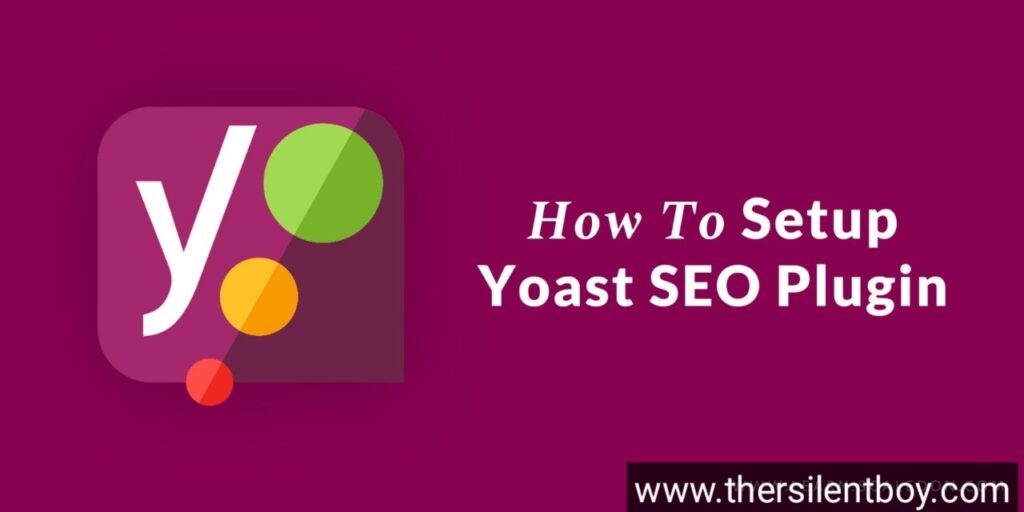
Intro:- How to Install and Setup Yoast SEO Plugin on WordPress Website? Yoast SEO adds canonical link elements throughout your website. This helps search engines understand which links they should index. For example, your archive pages have content from your posts. Yoast SEO helps Google understand that a post listed on archive pages has a canonical link pointing to the original post.
Yoast SEO is a WordPress plugin that improves your website’s rankings on search engines, by helping you optimize your site’s content and keywords. A lot of what Yoast SEO does is automated, but still needs your input and some planning.
CEO: Thijs de Valk (9 Nov 2021)Founder: Joost de Valk Founded: 2010 Initial release: 2007; 15 years ago.
About:-Yoast SEO is a search engine optimization plug-in for WordPress. This plugin has over 5 million active installations and has been downloaded more than 350 million times with over 25,000 five-star reviews on WordPress.org.
Yoast SEO is a WordPress plugin that improves your website’s rankings on search engines, by helping you optimize your site’s content and keywords. A lot of what Yoast SEO does is automated, but still needs your input and some planning.
How to Install and Setup Yoast SEO Plugin on WordPress Website? If you are reading this article that means you want to know how to Install and Set up Yoast SEO Plugin on WordPress Website, right? But, you don’t have any idea how or where to start. If you are looking for an easy guide on how to Install and Set up Yoast SEO plugins on WordPress Websites then you are in the right place. Just you have to read this article properly. In this article, I will show you a step-by-step tutorial on how to Install and Set up Yoast SEO Plugin on WordPress Website. Even if you are a beginner there is no worry about it. The steps below are for both beginners & experts.
But before beginning to start a blog, there are some major points that you should know, like(FAQs)
- What is Yoast SEO Plugin?
- What does Yoast SEO do?
- Is Yoast good for SEO?
- How do you do SEO with Yoast SEO?
- Can I use Yoast without WordPress?
- Which SEO Plugin is best for WordPress?
- Is Yoast SEO good for WordPress?
- Which is better Yoast SEO or All-in-one SEO?
- What is WordPress & why it is used?
- What is WordPress best for?
Let's Find It Out;
1. What is Yoast SEO Plugin?
Yoast SEO is a search engine optimization plug-in for WordPress. This plugin has over 5 million active installations and has been downloaded more than 350 million times with over 25,000 five-star reviews on WordPress.org.
2. What does Yoast SEO do?
Yoast SEO is a WordPress plugin that improves your website’s rankings on search engines, by helping you optimize your site’s content and keywords. A lot of what Yoast SEO does is automated, but still needs your input and some planning.
3. Is Yoast good for SEO?
Yes, Yoast SEO really works! Yoast SEO has been the most popular SEO plugin on WordPress for 11 years now. In fact, it has over 11 million downloads and a 5-star rating! You don’t stay that long in the game if you don’t have something to show for it.
4. How do you do SEO with Yoast SEO?
Using The Yoast SEO Configuration Wizard. After installing Yoast SEO, you can access the Yoast SEO dashboard by clicking on the new SEO tab in your WordPress dashboard. If this is your first time using the plugin, you should see a big notice for First-time SEO configuration.
5. Can I use Yoast without WordPress?
In addition to Yoast SEO for WordPress, our software is also available on other platforms and content management systems!
6. Which SEO plugin is best for WordPress?
Yoast SEO, Yoast SEO plugin is one of the most famous SEO plugins for WordPress.
7. Is Yoast SEO good for WordPress?
Every WordPress site needs an SEO plugin if they want to stand a chance of getting their pages to show up in search engine rankings. And when it comes to SEO plugins, Yoast SEO is by far one of the most popular options.
8. Which is better Yoast SEO or All-in-one SEO?
Yoast SEO and All-in-One SEO are both good plugins, so any comparison between the two plugins has to be close. However, All-in-one SEO wins in terms of ease of use, better user experience, and more control over different features.
9. What is WordPress and why It is used?
WordPress is a content management system (CMS) that allows you to host and build websites. WordPress contains plugin architecture and a template system, so you can customize any website to fit your business, blog, portfolio, or online store.
10. What is WordPress best for?
If you’re looking for a platform where you want to build your website, WordPress is one of the best in the business. Not only is it free—–yes, free!!!
Let's come to the point;
How to install Yoast SEO Plugin for WordPress
Do you want to properly install and set up the Yoast SEO plugin on WordPress Website? Yoast SEO is one of the most popular WordPress SEO plugins on the market and offers a comprehensive set of features to optimize your website. However, many beginners are not familiar with the SEO lingo and find it difficult to decide which plugin options they should turn on.
In this guide, we’ll walk you through the complete Yoast SEO plugin set up in WordPress and give your website an SEO boost.
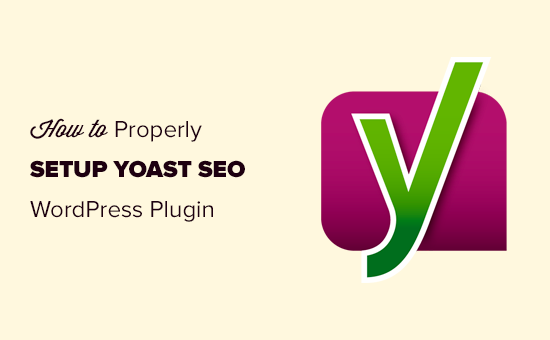
To install the free Yoast SEO for WordPress plugin on your WordPress site, follow the steps below.
1. Log in to your WordPress website.
When you’re logged in, you will be in your “Dashboard”.
2. Click on “Plugins”.
On the left-hand side, you will see a menu. In that menu, click on “Plugins”.
3. Search for “Yoast SEO”.
Click on “Add New” near the top of the screen. Type “Yoast SEO” in the search bar.

4. Click ” Install Now”.
Searching will give you a page of search results. The Yoast SEO plugin should be visible now. Click the “Install Now” button to start installing the plugin.
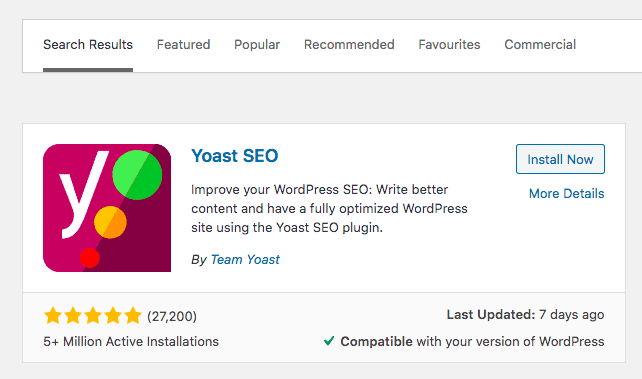
5. Activate the plugin.
Once the installation has finished, click the “Activate” button. It has appeared where the ” Install Now “ button was previously located.
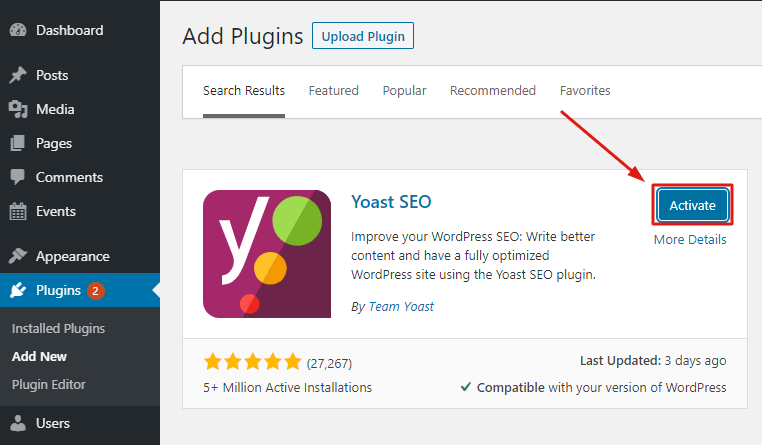
6. You’re done!!!
And How to Setup Yoast SEO Plugin for WordPress Website
You should remember, that the settings that we select are the ones that we recommend. Other experts may have their own preferences and discretion, so advanced users can ignore anything that they do not like. If you are a beginner, and you want to use Yoast’s WordPress SEO plugin as we do, then please follow along with the steps carefully. How to Install and Setup Yoast SEO Plugin on WordPress website.
Step 1. Import your SEO Data
If you are setting up Yoast SEO on a new WordPress website or blog, then you can skip this step. Other users, who are installing it on an existing website may have been using some other WordPress plugin for SEO like All in One SEO for WordPress, or a theme framework like Genesis dealing with your SEO data. How to Install and Setup Yoast SEO Plugin on WordPress Website?
If you want to successfully use this plugin, then you need to make sure that all of your previous data has been transported to this plugin before you deactivate the other one. To accomplish this, we recommend using the SEO Data Transporter plugin. It allows you to easily transport your SEO data between popular SEO plugins.
Step 2. General Settings
Clicking on the SEO icon takes you to the settings page for the plugin. Switch to the “General” tab and you will notice a button to open the configuration wizard. We want you to ignore this wizard because we will be taking you step by step through each option.
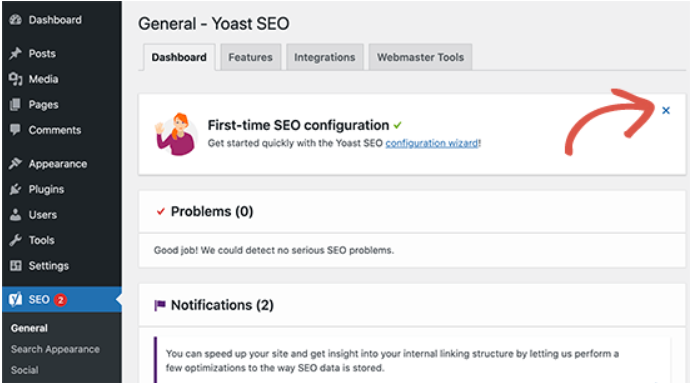
Step 3. Features
Yoast SEO comes with a lot of features. This page allows you to easily turn those features on and off. By default, all options on this page are turned on.

We’ll talk about some of them later in this article. For now, let’s take a quick look at each item and what it does.
- SEO analysis: This shows the SEO score and analysis for your content.
- Readability analysis: This shows the readability analysis and score for your content.
- Cornerstone content: This feature allows you to mark and filter cornerstone content. These are your most important pillar articles.
- Text link counter: This feature shows the number of internal text links to and from an article.
- XML sitemaps: Creates XML sitemaps for your website.
- Admin bar menu: Shows Yoast SEO menu in the WordPress admin toolbar.
- Security: no advanced settings for authors: Hides advanced SEO settings from authors to improve security.
- Usage tracking: Allows plugin author to track some usage data. It is turned off by default.
- REST API: Head endpoint: This Yoast SEO REST API endpoint allows you or anyone else to fetch SEO data for specific WordPress posts or pages. We recommend that you turn this feature off if you are not building a headless WordPress site.
- Enhanced Slack sharing: This feature adds an author byline and reading time estimate to the article’s snippet when shared on Slack.
Don’t forget to click on the “Save Changes” button to store your settings.
Step 4. Integrations
Yoast SEO offers built-in integration for SEMRush and Ryte platforms.

SEMRush is one of the best SEO tools on the market. This integration helps you find related keywords that match your focus keyword and then improve your content accordingly. Ryte is an online tool that checks your website for indexability and alerts you in the Site Health report when it is not indexable by search engines. We recommend leaving them both on. How to Install and Setup Yoast SEO Plugin on WordPress Website?
Step 5. Webmaster Tools
Popular search engines allow site owners to add their sites using the webmaster’s tools area. See our complete Google Search Console guide to learn more about these tools. Yoast SEO makes it easier to verify your website with all top search engines. In order to do that you need to sign up for the webmaster tools program for each search engine.
After that, you’ll be asked to add a meta tag to verify your ownership of the website. Simply add the meta code that you received from the search engines in the respective fields.
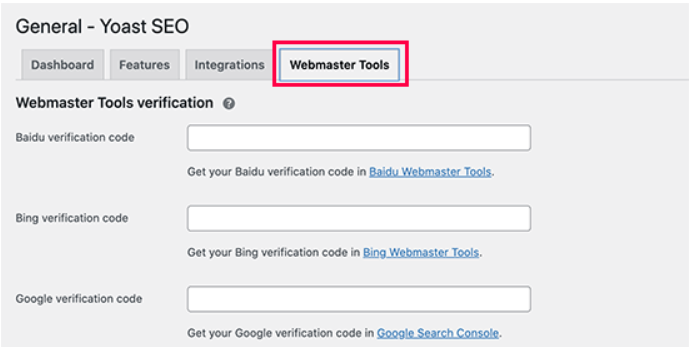
Step 6. Search Appearance
Search Appearance in Yoast SEO settings controls how your website appears in search results. This includes several options for your homepage, single articles, archives, and taxonomies. We’ll walk you through each one of them. Let’s start with the general settings first,
1. General
Here you can choose the symbol you want to use as a separator between titles. The default option is a dash, you can use it if you are unsure which symbol to choose.

On this page, you can also choose the SEO title and meta description for your website’s homepage.

Note: If you are using a static home page, then you can homepage title and description by editing the page individually.
After that, you will find the knowledge graph and schema options for your website. You can choose whether your website represents an organization or an individual.
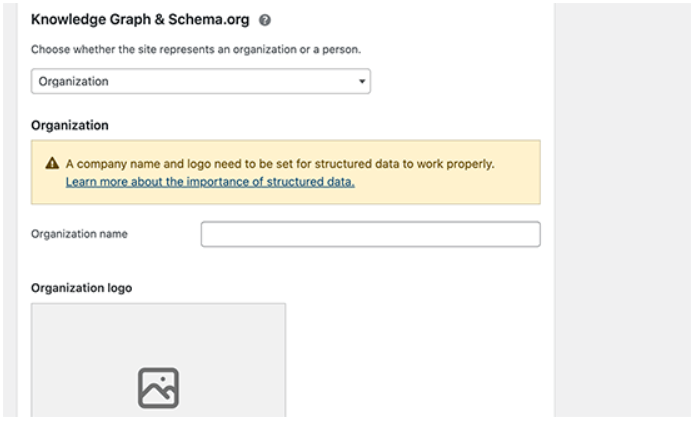
You can also upload a profile picture for the individual or a website logo for a business.
2. content Types
You can choose an SEO title and description for each post or page that you write. Yoast SEO also allows you to set up an automatic template to use for them. In case you forget to add them manually, these options will allow Yoast SEO to use default settings to automatically fill in those options.
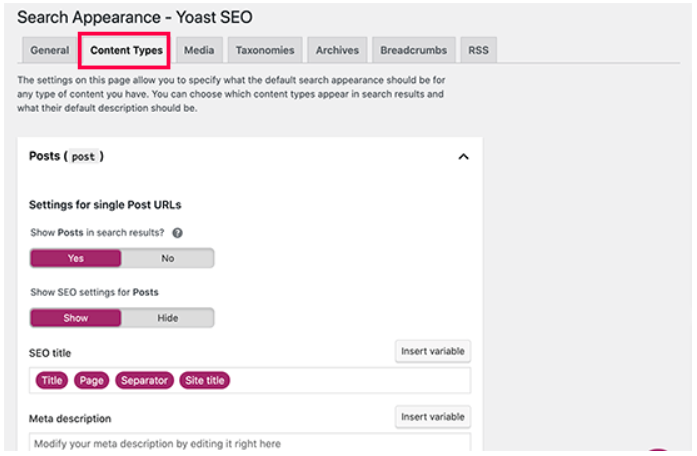
You will be able to set search appearance and whether or not to show SEO meta box for each content type. The default options would work for all websites. After that, you can set the SEO title template and a default meta description. However, we recommend you only tweak the SEO title and leave the meta description field blank. This would allow Yoast SEO to dynamically generate a description from the first few lines of your article.
3. Media
By default, WordPress creates a new page for each image or media you attach to your posts and pages. This page only displays the attachment media. Those attachment pages have no significant text to provide search engines a context. Such pages are considered low-quality content by search engines and have a negative SEO impact.
Yoast SEO helps you fix that by redirecting users to the attachment file instead of the attachment page. This option is set to “Yes” by default and you don’t need to change it.

4. Taxonomies
On the taxonomies tab, you can configure titles and meta for categories, tags, custom taxonomies, and post-format archives. Default template variables should work for most sites. As for descriptions, please remember that Yoast SEO picks up descriptions from your categories and tags.
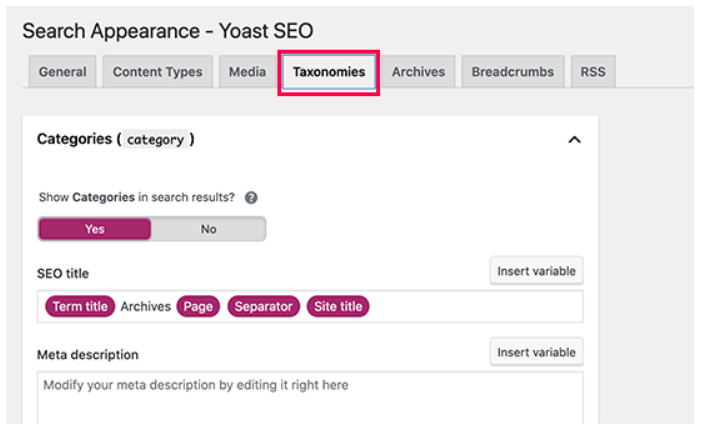
5. Archives
The Archives tab allows you to control search appearance options for miscellaneous archive pages on your website. This includes author, date, search, and 404 pages. The default options will work for most websites. However, if you run a single-author blog, then you need to disable author archive pages from serach engines.
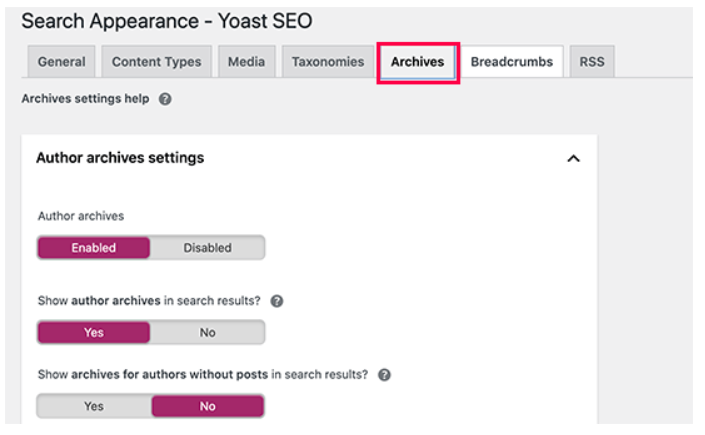
On a single blog, the author archive pages are exactly like the data archive or your blog pages. This creates duplicate content which affects your SEO rankings.
6. Breadcrumbs
Breadcrumbs are great for internal because it defines a clear path or trail to the page you are on. These breadcrumbs also appear in search results giving your site extra advantage in the search. The default settings should work for most websites, but if you want to change something then go ahead and make your changes.
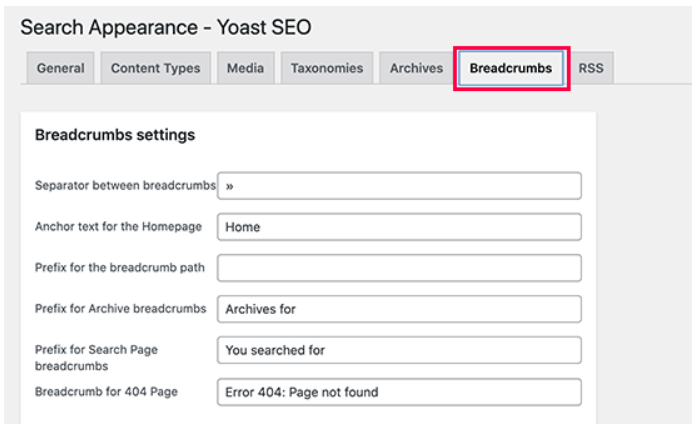
Make sure you set the option to “Enabled” to make it visible with your WordPress theme.
7. RSS
RSS feeds are often used by content scrapers to copy content from your website. Yoast SEO allows you to add a backlink to your own site for each post in your RSS feed.

This way, you will get backlinks from their site, and Google will know that you are the original source. There are options to add your author link, post link, blog link, and blog description. So get creative. This can also be used to add advertisements to your RSS feed.
Step 7. Social
As we said earlier, Yoast SEO is a powerhouse packed with many features to provide comprehensive optimization. One great feature of the plugin is that it integrates your site with Facebook, Twitter, Pinterest, and other platforms. Clicking on the Social link under the SEO menu will take you to set up these platforms. We will show you how to configure each of them.
1. Accounts
The first tab under the social settings is for all your social accounts. This allows Yoast SEO to tell Google about your social profiles. You need to simply add the URLs and Twitter usernames for the main social profiles of your site.
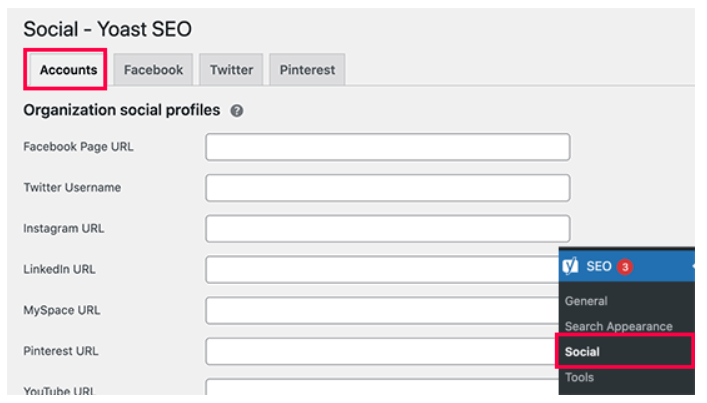
2. Facebook
You need to make sure that the open graph metadata option is enabled under the Facebook tab. It allows Yoast SEO to add Facebook open graph metadata in your website’s <head> section.

You can set the image you want to use for your homepage. This will help Facebook pick up the right thumbnail and page information when a post from your website is shared on Facebook. Below that, you will add a title and description for your homepage. This title and description will be used when your homepage is shared on Facebook.
Additionally, you can provide a default thumbnail image URL. This image will be used for all articles that do not have a thumbnail or any other image.

3. Twitter
As for Twitter, you can add Twitter cards to your site’s head section. You can also choose the card type to use. We recommend using a summary with a large image.

4. Pinterest
Pinterest uses Open Graph meta data just like Facebook. Make sure that you have the open graph metadata box checked under Facebook settings. After that, you just need to enter the site verification code provided by Pinterest. Simply visit your Pinterest account settings to add and verify your site. You will be provided with a meta tag that you need to enter here.

Step 8. Tools
Yoast SEO comes with some built-in tools that allow you to perform some advanced tasks. Most beginners may not need to use these tools. However, we will show you each tool and what it does.

1. Import and Export
If you previously used another WordPress SEO plugin or a theme with built-in SEO functions, then you can use this tool to import SEO data.
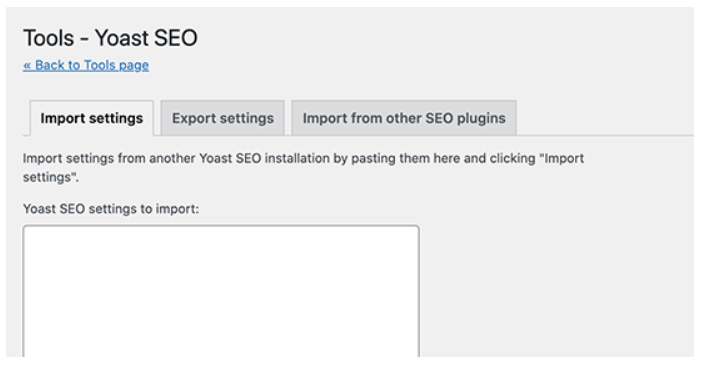
You can also use it to import and export Yoast SEO plugin settings and use them on a different WordPress site.
2. File editor
As your WordPress site grows, you may often come across tutorials asking you to add some code to your website’s .htaccess file or robots.txt file. Both of them are configuration files and have a huge impact on your website’s SEO. Yoast SEO allows you to easily edit both files directly from the WordPress admin area.
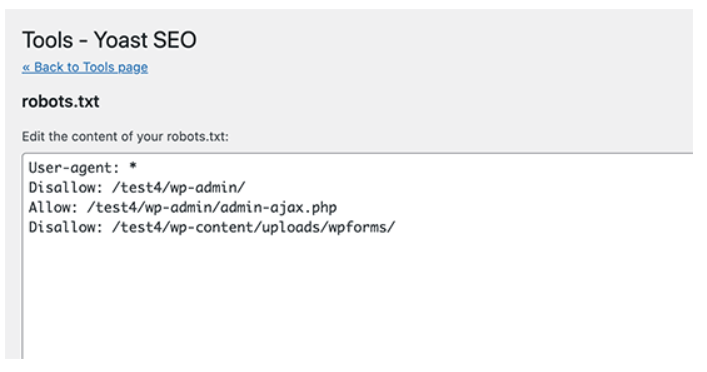
3. Bulk editor
The bulk editor tool in Yoast SEO allows you to quickly add SEO titles and descriptions for all your blog posts and pages. Under the Titles tab, you will find a blank field to add your new SEO title for that blog post. After that click on the save link to store your changes.
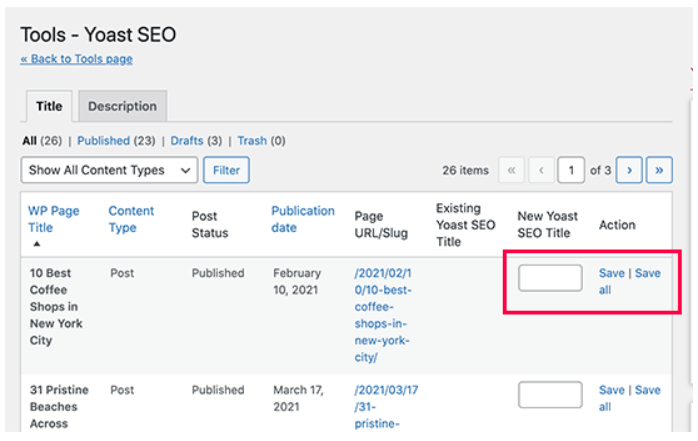
To add descriptions, you will need to switch to the descriptions tab. Once again, you will be able to add a description for each blog post or page and save it.
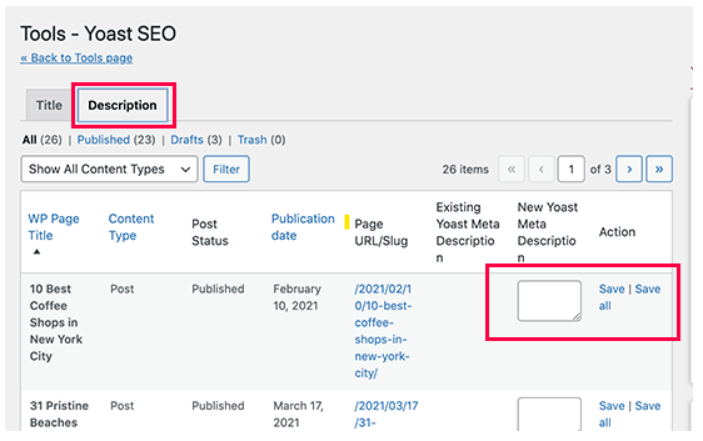
Step 9. Redirects Manager(Premium)
Yoast SEO Premium adds a powerful redirect manager. This allows you to quickly set up redirects on your WordPress site. Using the redirect manager you can quickly fix 404 errors, redirect users from an old article to a new one, and more.
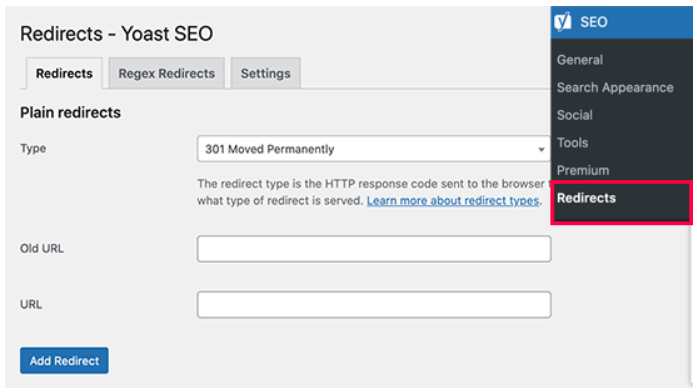
You can also use a dedicated redirect manager like Redirection to manage your redirects. This allows you to keep redirects working even if you stop using Yoast SEO.
Step 10. Optimizing Your Posts and Pages with Yoast SEO
Just installing and setting up this plugin is not enough. In order for you to really maximize the benefit of this plugin, you need to customize the settings on per post basis.
Let’s take a look at how you can maximize the benefits by optimizing each post/page in WordPress. Simply edit any post or page and you’ll notice a new Yoast SEO meta box below the post editor.
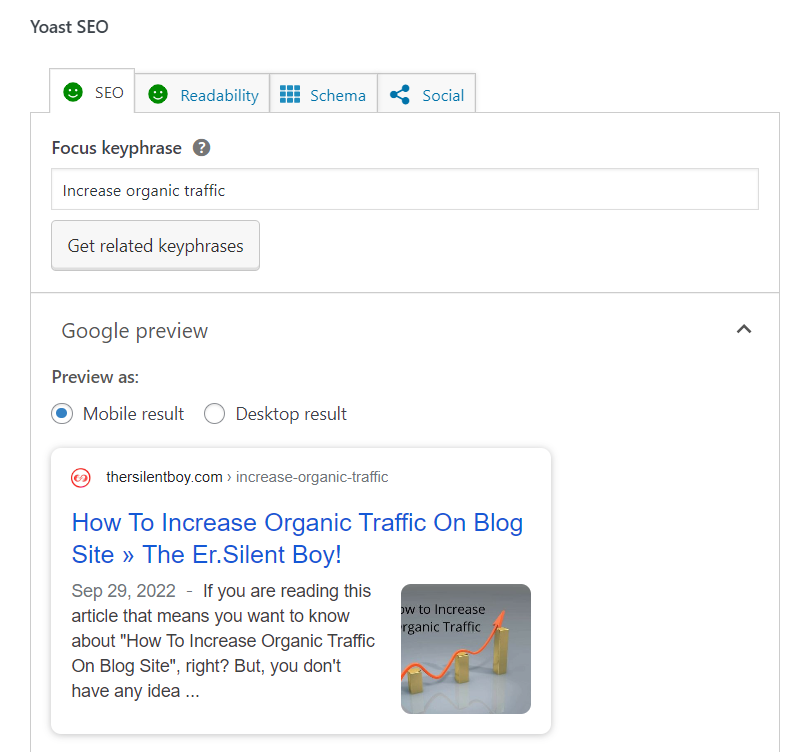
You can start by adding a focus keyphrase or keyword. This is the main keyword, which you think your users will enter in search engines to find this post. After that, Yoast SEO will check your post content for SEO and Readability analysis. You can view the analysis to further improve your article. How to Install and Setup Yoast SEO Plugin on WordPress Website?
Sometimes your post title and your SEO title might not be the same. Every time, you should write a custom SEO description because the except generator only picks up the first paragraph which might not be the most important one.
Step 11. Optimizing Taxonomies for SEO ( Categories and Tags )
Just like your post and pages, you can also override the SEO title and meta descriptions for category, tag, and author archive pages.
Simply visit the Posts>>Categories page and click on the edit link below any category. On the category edit page, scroll down to the bottom and you will see the Yoast SEO meta box.
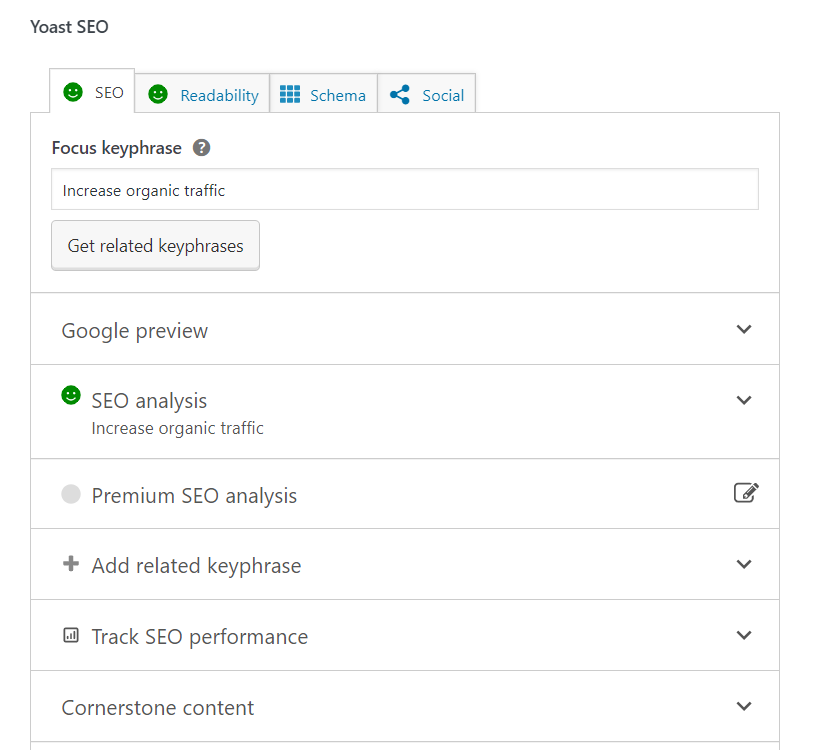
You can do that for all your categories, tags, and custom taxonomy archives.
Step 12. Optimizing Ecommerce Products
Yoast SEO comes with full support for online stores and eCommerce websites using WooCommerce. This allows you to optimize your product pages just like you would optimize blog posts and pages. You’ll find all eCommerce SEO options when adding a new product to your website. You can also edit any old product and optimize it by entering a focus keyword, SEO title, SEO description and more,

I hope this guide helped you how to install and set up the Yoast SEO plugin on the WordPress website.
If you liked this article, then, please leave a comment below. And you can also find us on Insta, Pinterest, WhatsApp & LinkedIn.

Authored By The Er. Pramod Adhikari!
A Blogger, Author & CEO’s The Infinity Company! B. Tech in CSE(Computer Science & Engineering) from Sambhram College, Bengaluru-560097, Working worldwide as Software(Web/App) Developer!

